Intercultural Management in Business: Gender Roles and Communication
VerifiedAdded on 2023/01/10
|8
|2146
|41
Literature Review
AI Summary
This literature review examines intercultural management in business, focusing on the impact of femininity and masculinity on workplace structures and international business strategies. The report analyzes gender stereotypes, the role of women in the workplace, and the integration of feminine traits for enhanced engagement. It also explores the influence of masculinity, including its impact on work dynamics and leadership styles. The review emphasizes the importance of communication across cultures, the significance of cross-cultural training, and the implementation of various strategies to manage cross-cultural situations effectively. The conclusion highlights the key role of intercultural management in facilitating effective employee management and successful international business operations, while also emphasizing the need for a balanced approach that promotes both masculinity and femininity in the workplace. The report also references several books and journals to support its findings.
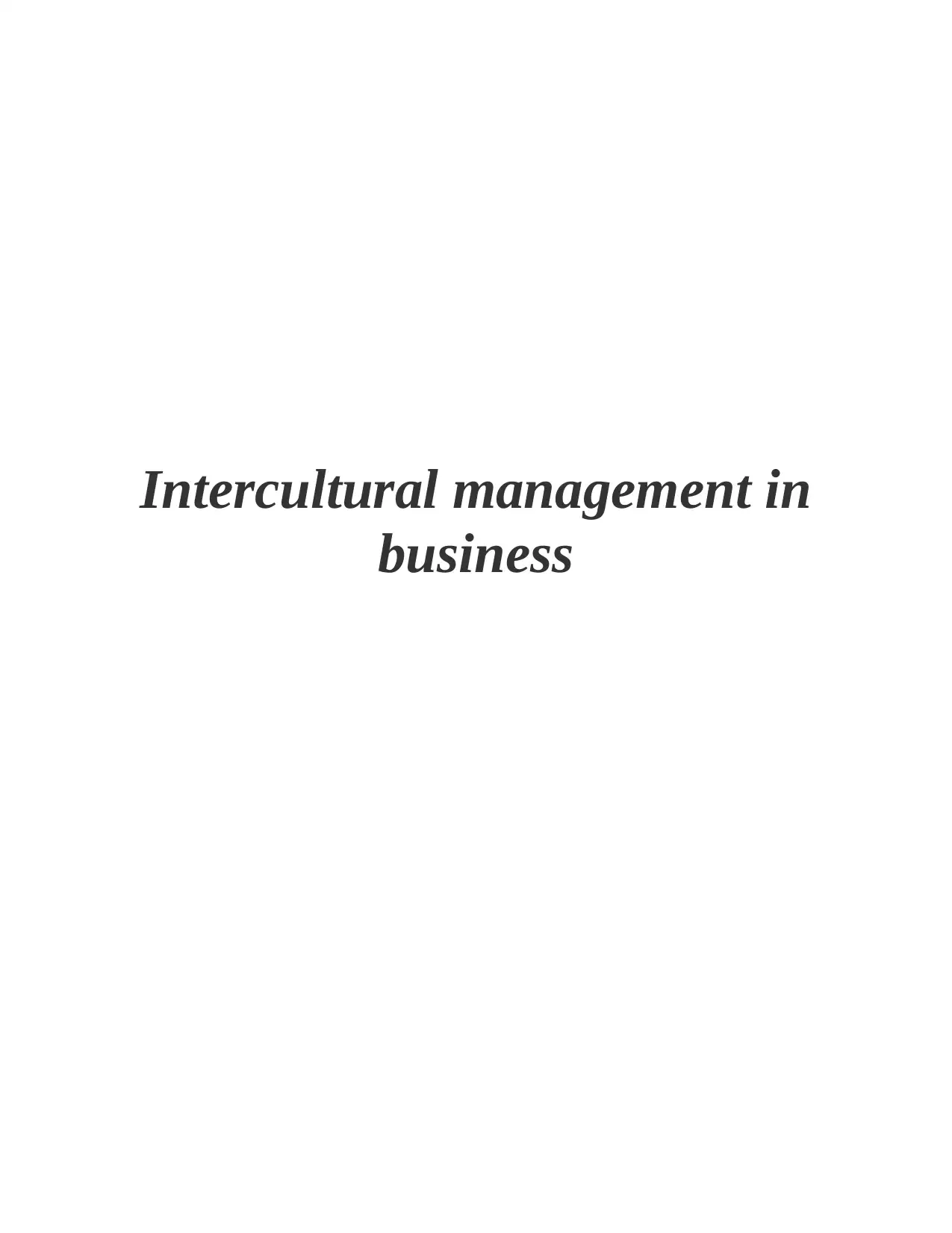
Intercultural management in
business
business
Paraphrase This Document
Need a fresh take? Get an instant paraphrase of this document with our AI Paraphraser
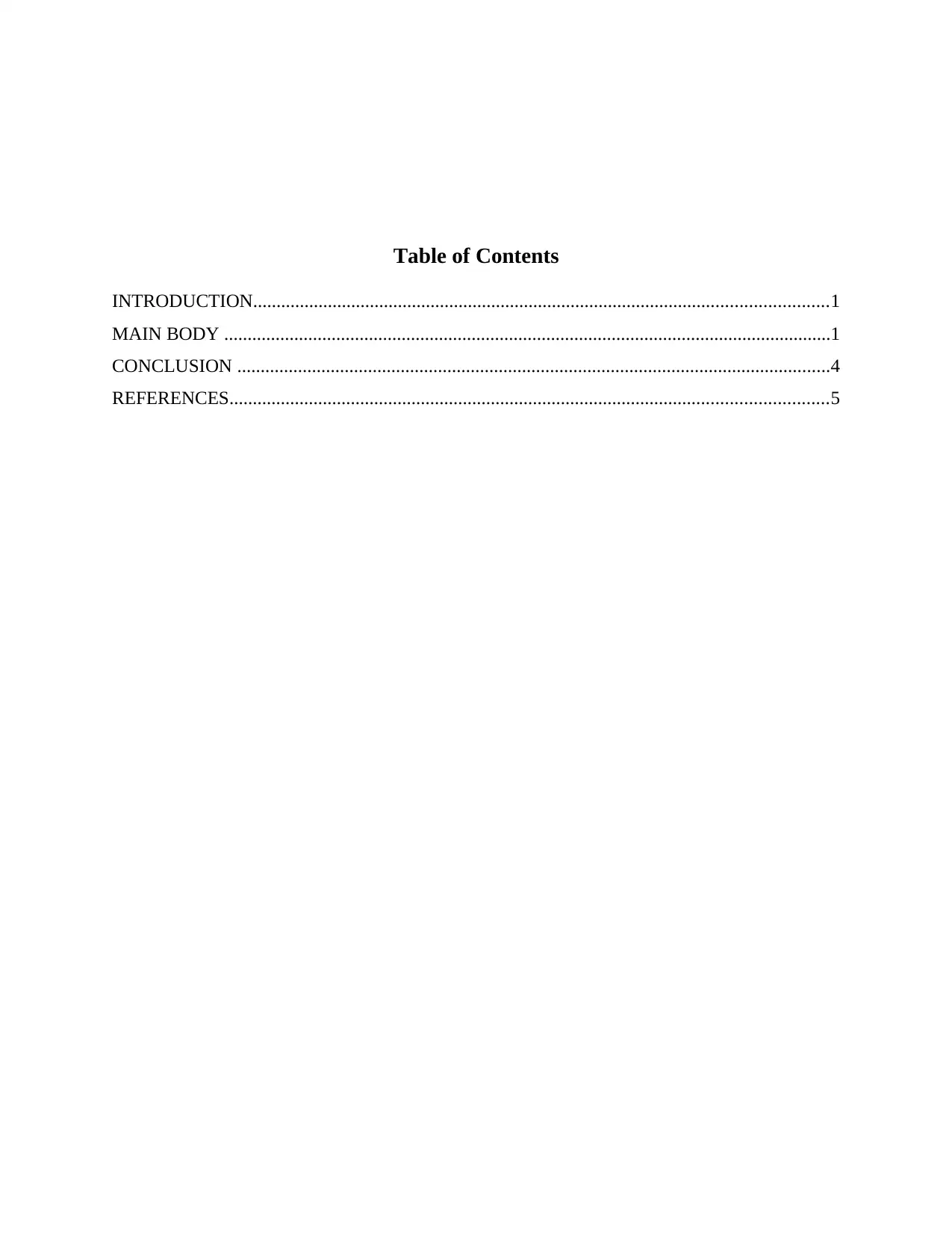
Table of Contents
INTRODUCTION...........................................................................................................................1
MAIN BODY ..................................................................................................................................1
CONCLUSION ...............................................................................................................................4
REFERENCES................................................................................................................................5
INTRODUCTION...........................................................................................................................1
MAIN BODY ..................................................................................................................................1
CONCLUSION ...............................................................................................................................4
REFERENCES................................................................................................................................5
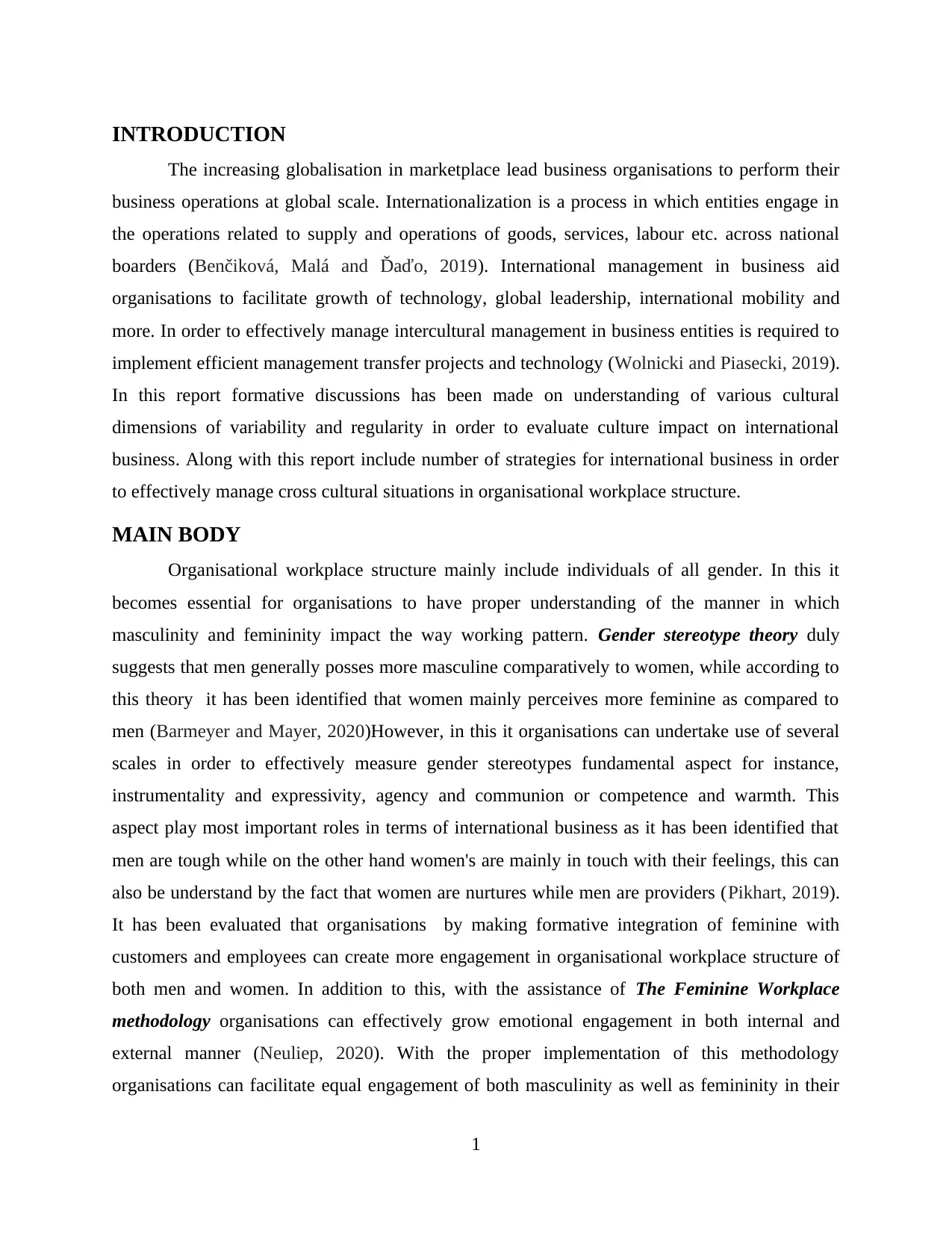
INTRODUCTION
The increasing globalisation in marketplace lead business organisations to perform their
business operations at global scale. Internationalization is a process in which entities engage in
the operations related to supply and operations of goods, services, labour etc. across national
boarders (Benčiková, Malá and Ďaďo, 2019). International management in business aid
organisations to facilitate growth of technology, global leadership, international mobility and
more. In order to effectively manage intercultural management in business entities is required to
implement efficient management transfer projects and technology (Wolnicki and Piasecki, 2019).
In this report formative discussions has been made on understanding of various cultural
dimensions of variability and regularity in order to evaluate culture impact on international
business. Along with this report include number of strategies for international business in order
to effectively manage cross cultural situations in organisational workplace structure.
MAIN BODY
Organisational workplace structure mainly include individuals of all gender. In this it
becomes essential for organisations to have proper understanding of the manner in which
masculinity and femininity impact the way working pattern. Gender stereotype theory duly
suggests that men generally posses more masculine comparatively to women, while according to
this theory it has been identified that women mainly perceives more feminine as compared to
men (Barmeyer and Mayer, 2020)However, in this it organisations can undertake use of several
scales in order to effectively measure gender stereotypes fundamental aspect for instance,
instrumentality and expressivity, agency and communion or competence and warmth. This
aspect play most important roles in terms of international business as it has been identified that
men are tough while on the other hand women's are mainly in touch with their feelings, this can
also be understand by the fact that women are nurtures while men are providers (Pikhart, 2019).
It has been evaluated that organisations by making formative integration of feminine with
customers and employees can create more engagement in organisational workplace structure of
both men and women. In addition to this, with the assistance of The Feminine Workplace
methodology organisations can effectively grow emotional engagement in both internal and
external manner (Neuliep, 2020). With the proper implementation of this methodology
organisations can facilitate equal engagement of both masculinity as well as femininity in their
1
The increasing globalisation in marketplace lead business organisations to perform their
business operations at global scale. Internationalization is a process in which entities engage in
the operations related to supply and operations of goods, services, labour etc. across national
boarders (Benčiková, Malá and Ďaďo, 2019). International management in business aid
organisations to facilitate growth of technology, global leadership, international mobility and
more. In order to effectively manage intercultural management in business entities is required to
implement efficient management transfer projects and technology (Wolnicki and Piasecki, 2019).
In this report formative discussions has been made on understanding of various cultural
dimensions of variability and regularity in order to evaluate culture impact on international
business. Along with this report include number of strategies for international business in order
to effectively manage cross cultural situations in organisational workplace structure.
MAIN BODY
Organisational workplace structure mainly include individuals of all gender. In this it
becomes essential for organisations to have proper understanding of the manner in which
masculinity and femininity impact the way working pattern. Gender stereotype theory duly
suggests that men generally posses more masculine comparatively to women, while according to
this theory it has been identified that women mainly perceives more feminine as compared to
men (Barmeyer and Mayer, 2020)However, in this it organisations can undertake use of several
scales in order to effectively measure gender stereotypes fundamental aspect for instance,
instrumentality and expressivity, agency and communion or competence and warmth. This
aspect play most important roles in terms of international business as it has been identified that
men are tough while on the other hand women's are mainly in touch with their feelings, this can
also be understand by the fact that women are nurtures while men are providers (Pikhart, 2019).
It has been evaluated that organisations by making formative integration of feminine with
customers and employees can create more engagement in organisational workplace structure of
both men and women. In addition to this, with the assistance of The Feminine Workplace
methodology organisations can effectively grow emotional engagement in both internal and
external manner (Neuliep, 2020). With the proper implementation of this methodology
organisations can facilitate equal engagement of both masculinity as well as femininity in their
1
⊘ This is a preview!⊘
Do you want full access?
Subscribe today to unlock all pages.

Trusted by 1+ million students worldwide
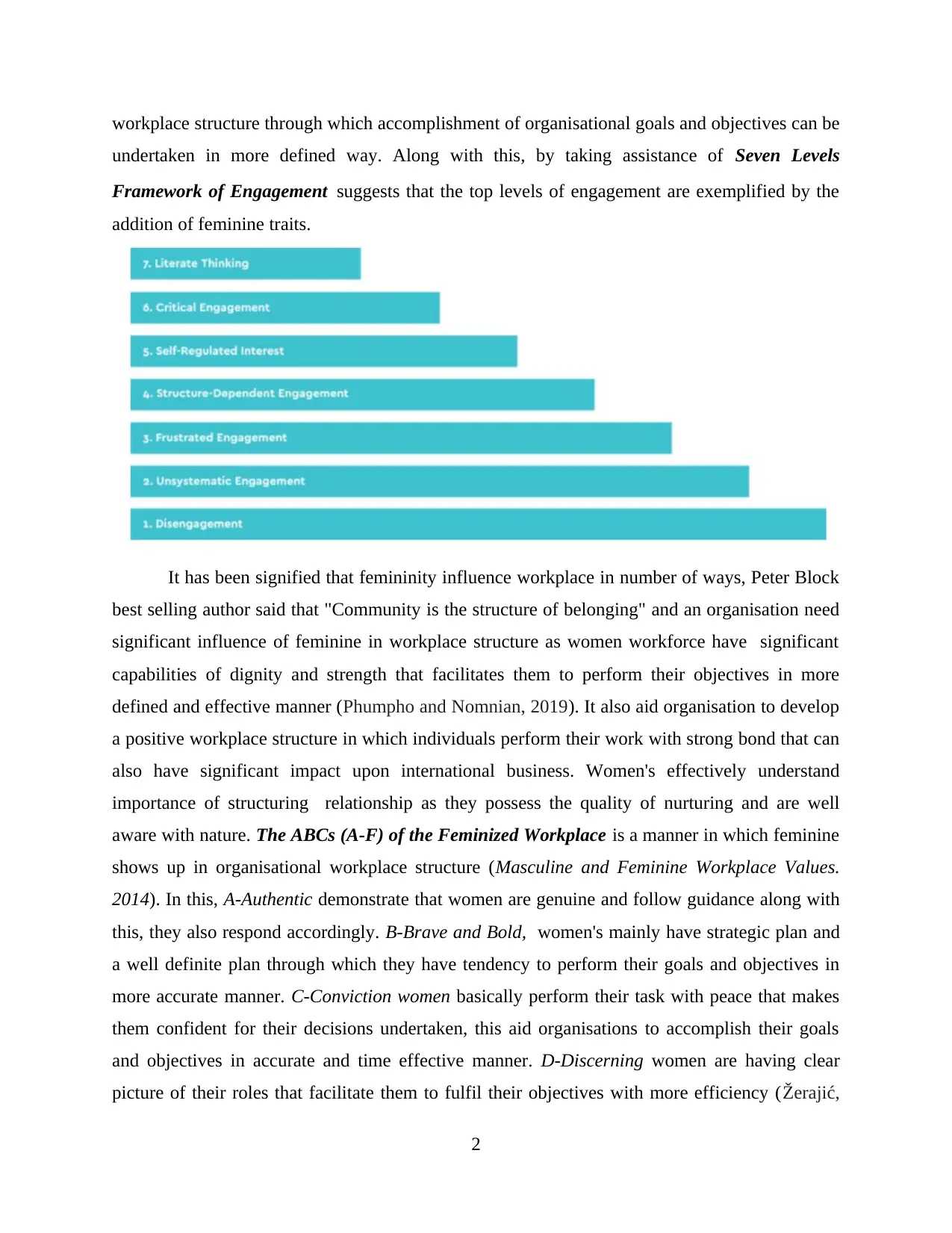
workplace structure through which accomplishment of organisational goals and objectives can be
undertaken in more defined way. Along with this, by taking assistance of Seven Levels
Framework of Engagement suggests that the top levels of engagement are exemplified by the
addition of feminine traits.
It has been signified that femininity influence workplace in number of ways, Peter Block
best selling author said that "Community is the structure of belonging" and an organisation need
significant influence of feminine in workplace structure as women workforce have significant
capabilities of dignity and strength that facilitates them to perform their objectives in more
defined and effective manner (Phumpho and Nomnian, 2019). It also aid organisation to develop
a positive workplace structure in which individuals perform their work with strong bond that can
also have significant impact upon international business. Women's effectively understand
importance of structuring relationship as they possess the quality of nurturing and are well
aware with nature. The ABCs (A-F) of the Feminized Workplace is a manner in which feminine
shows up in organisational workplace structure (Masculine and Feminine Workplace Values.
2014). In this, A-Authentic demonstrate that women are genuine and follow guidance along with
this, they also respond accordingly. B-Brave and Bold, women's mainly have strategic plan and
a well definite plan through which they have tendency to perform their goals and objectives in
more accurate manner. C-Conviction women basically perform their task with peace that makes
them confident for their decisions undertaken, this aid organisations to accomplish their goals
and objectives in accurate and time effective manner. D-Discerning women are having clear
picture of their roles that facilitate them to fulfil their objectives with more efficiency (Žerajić,
2
undertaken in more defined way. Along with this, by taking assistance of Seven Levels
Framework of Engagement suggests that the top levels of engagement are exemplified by the
addition of feminine traits.
It has been signified that femininity influence workplace in number of ways, Peter Block
best selling author said that "Community is the structure of belonging" and an organisation need
significant influence of feminine in workplace structure as women workforce have significant
capabilities of dignity and strength that facilitates them to perform their objectives in more
defined and effective manner (Phumpho and Nomnian, 2019). It also aid organisation to develop
a positive workplace structure in which individuals perform their work with strong bond that can
also have significant impact upon international business. Women's effectively understand
importance of structuring relationship as they possess the quality of nurturing and are well
aware with nature. The ABCs (A-F) of the Feminized Workplace is a manner in which feminine
shows up in organisational workplace structure (Masculine and Feminine Workplace Values.
2014). In this, A-Authentic demonstrate that women are genuine and follow guidance along with
this, they also respond accordingly. B-Brave and Bold, women's mainly have strategic plan and
a well definite plan through which they have tendency to perform their goals and objectives in
more accurate manner. C-Conviction women basically perform their task with peace that makes
them confident for their decisions undertaken, this aid organisations to accomplish their goals
and objectives in accurate and time effective manner. D-Discerning women are having clear
picture of their roles that facilitate them to fulfil their objectives with more efficiency (Žerajić,
2
Paraphrase This Document
Need a fresh take? Get an instant paraphrase of this document with our AI Paraphraser
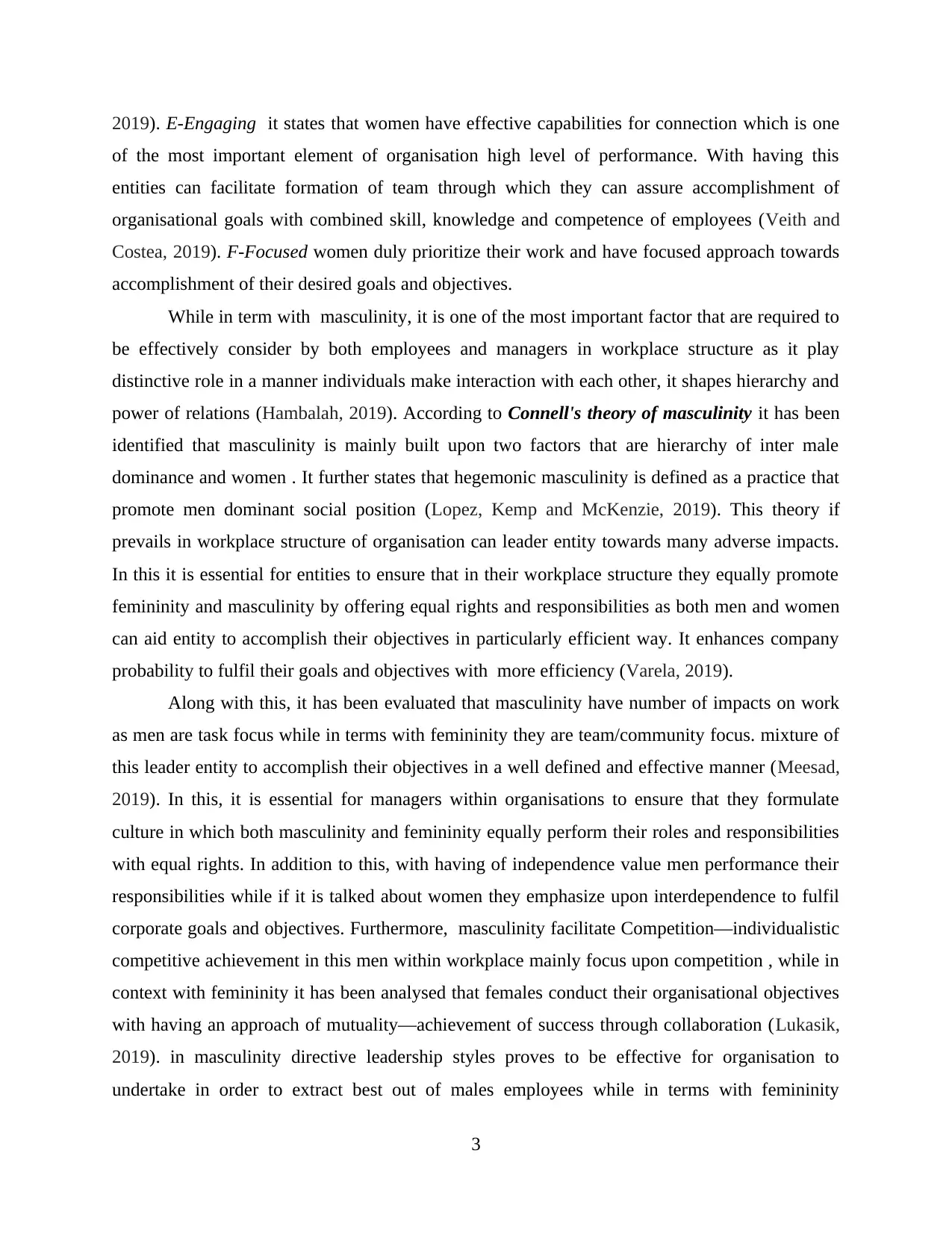
2019). E-Engaging it states that women have effective capabilities for connection which is one
of the most important element of organisation high level of performance. With having this
entities can facilitate formation of team through which they can assure accomplishment of
organisational goals with combined skill, knowledge and competence of employees (Veith and
Costea, 2019). F-Focused women duly prioritize their work and have focused approach towards
accomplishment of their desired goals and objectives.
While in term with masculinity, it is one of the most important factor that are required to
be effectively consider by both employees and managers in workplace structure as it play
distinctive role in a manner individuals make interaction with each other, it shapes hierarchy and
power of relations (Hambalah, 2019). According to Connell's theory of masculinity it has been
identified that masculinity is mainly built upon two factors that are hierarchy of inter male
dominance and women . It further states that hegemonic masculinity is defined as a practice that
promote men dominant social position (Lopez, Kemp and McKenzie, 2019). This theory if
prevails in workplace structure of organisation can leader entity towards many adverse impacts.
In this it is essential for entities to ensure that in their workplace structure they equally promote
femininity and masculinity by offering equal rights and responsibilities as both men and women
can aid entity to accomplish their objectives in particularly efficient way. It enhances company
probability to fulfil their goals and objectives with more efficiency (Varela, 2019).
Along with this, it has been evaluated that masculinity have number of impacts on work
as men are task focus while in terms with femininity they are team/community focus. mixture of
this leader entity to accomplish their objectives in a well defined and effective manner (Meesad,
2019). In this, it is essential for managers within organisations to ensure that they formulate
culture in which both masculinity and femininity equally perform their roles and responsibilities
with equal rights. In addition to this, with having of independence value men performance their
responsibilities while if it is talked about women they emphasize upon interdependence to fulfil
corporate goals and objectives. Furthermore, masculinity facilitate Competition—individualistic
competitive achievement in this men within workplace mainly focus upon competition , while in
context with femininity it has been analysed that females conduct their organisational objectives
with having an approach of mutuality—achievement of success through collaboration (Lukasik,
2019). in masculinity directive leadership styles proves to be effective for organisation to
undertake in order to extract best out of males employees while in terms with femininity
3
of the most important element of organisation high level of performance. With having this
entities can facilitate formation of team through which they can assure accomplishment of
organisational goals with combined skill, knowledge and competence of employees (Veith and
Costea, 2019). F-Focused women duly prioritize their work and have focused approach towards
accomplishment of their desired goals and objectives.
While in term with masculinity, it is one of the most important factor that are required to
be effectively consider by both employees and managers in workplace structure as it play
distinctive role in a manner individuals make interaction with each other, it shapes hierarchy and
power of relations (Hambalah, 2019). According to Connell's theory of masculinity it has been
identified that masculinity is mainly built upon two factors that are hierarchy of inter male
dominance and women . It further states that hegemonic masculinity is defined as a practice that
promote men dominant social position (Lopez, Kemp and McKenzie, 2019). This theory if
prevails in workplace structure of organisation can leader entity towards many adverse impacts.
In this it is essential for entities to ensure that in their workplace structure they equally promote
femininity and masculinity by offering equal rights and responsibilities as both men and women
can aid entity to accomplish their objectives in particularly efficient way. It enhances company
probability to fulfil their goals and objectives with more efficiency (Varela, 2019).
Along with this, it has been evaluated that masculinity have number of impacts on work
as men are task focus while in terms with femininity they are team/community focus. mixture of
this leader entity to accomplish their objectives in a well defined and effective manner (Meesad,
2019). In this, it is essential for managers within organisations to ensure that they formulate
culture in which both masculinity and femininity equally perform their roles and responsibilities
with equal rights. In addition to this, with having of independence value men performance their
responsibilities while if it is talked about women they emphasize upon interdependence to fulfil
corporate goals and objectives. Furthermore, masculinity facilitate Competition—individualistic
competitive achievement in this men within workplace mainly focus upon competition , while in
context with femininity it has been analysed that females conduct their organisational objectives
with having an approach of mutuality—achievement of success through collaboration (Lukasik,
2019). in masculinity directive leadership styles proves to be effective for organisation to
undertake in order to extract best out of males employees while in terms with femininity
3
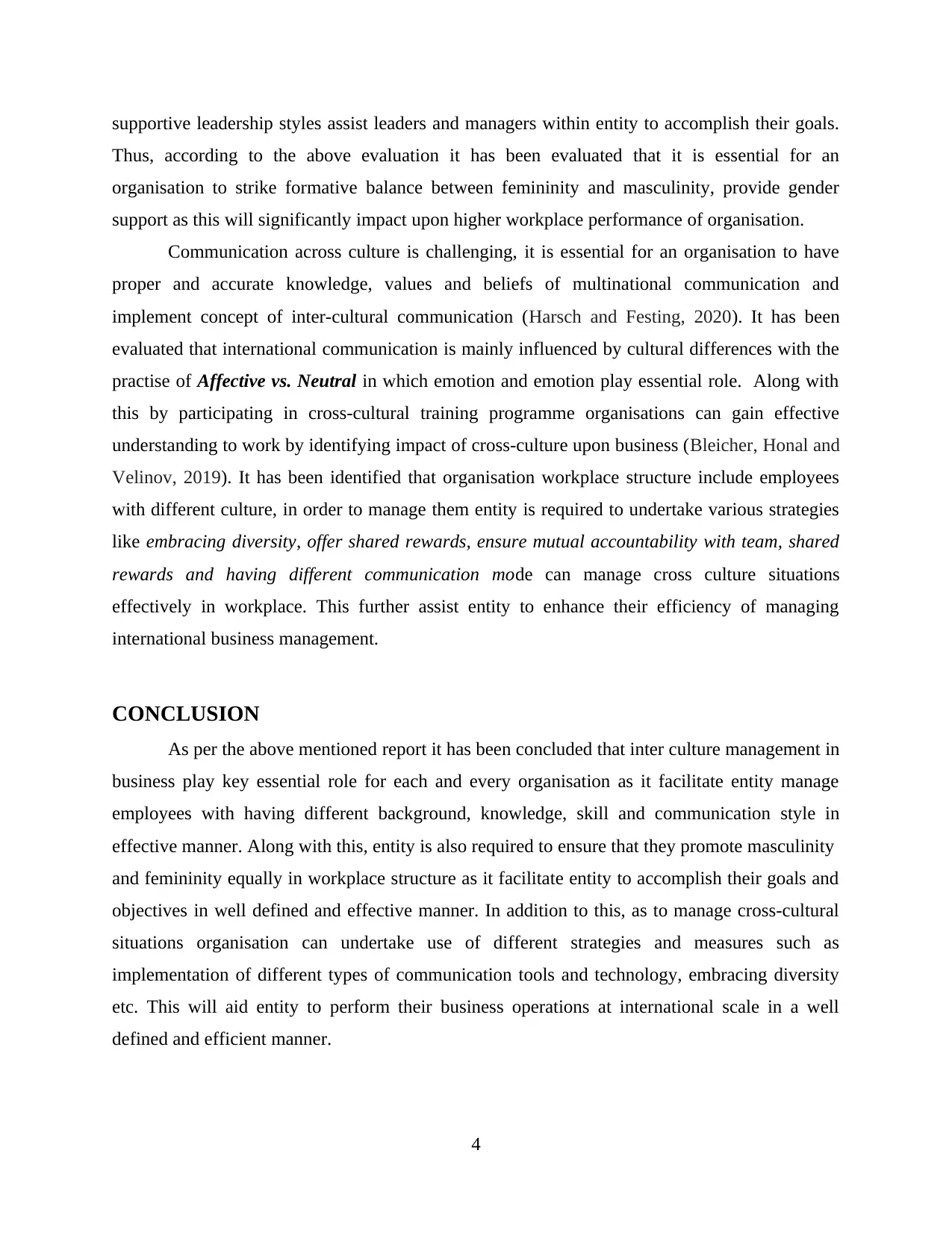
supportive leadership styles assist leaders and managers within entity to accomplish their goals.
Thus, according to the above evaluation it has been evaluated that it is essential for an
organisation to strike formative balance between femininity and masculinity, provide gender
support as this will significantly impact upon higher workplace performance of organisation.
Communication across culture is challenging, it is essential for an organisation to have
proper and accurate knowledge, values and beliefs of multinational communication and
implement concept of inter-cultural communication (Harsch and Festing, 2020). It has been
evaluated that international communication is mainly influenced by cultural differences with the
practise of Affective vs. Neutral in which emotion and emotion play essential role. Along with
this by participating in cross-cultural training programme organisations can gain effective
understanding to work by identifying impact of cross-culture upon business (Bleicher, Honal and
Velinov, 2019). It has been identified that organisation workplace structure include employees
with different culture, in order to manage them entity is required to undertake various strategies
like embracing diversity, offer shared rewards, ensure mutual accountability with team, shared
rewards and having different communication mode can manage cross culture situations
effectively in workplace. This further assist entity to enhance their efficiency of managing
international business management.
CONCLUSION
As per the above mentioned report it has been concluded that inter culture management in
business play key essential role for each and every organisation as it facilitate entity manage
employees with having different background, knowledge, skill and communication style in
effective manner. Along with this, entity is also required to ensure that they promote masculinity
and femininity equally in workplace structure as it facilitate entity to accomplish their goals and
objectives in well defined and effective manner. In addition to this, as to manage cross-cultural
situations organisation can undertake use of different strategies and measures such as
implementation of different types of communication tools and technology, embracing diversity
etc. This will aid entity to perform their business operations at international scale in a well
defined and efficient manner.
4
Thus, according to the above evaluation it has been evaluated that it is essential for an
organisation to strike formative balance between femininity and masculinity, provide gender
support as this will significantly impact upon higher workplace performance of organisation.
Communication across culture is challenging, it is essential for an organisation to have
proper and accurate knowledge, values and beliefs of multinational communication and
implement concept of inter-cultural communication (Harsch and Festing, 2020). It has been
evaluated that international communication is mainly influenced by cultural differences with the
practise of Affective vs. Neutral in which emotion and emotion play essential role. Along with
this by participating in cross-cultural training programme organisations can gain effective
understanding to work by identifying impact of cross-culture upon business (Bleicher, Honal and
Velinov, 2019). It has been identified that organisation workplace structure include employees
with different culture, in order to manage them entity is required to undertake various strategies
like embracing diversity, offer shared rewards, ensure mutual accountability with team, shared
rewards and having different communication mode can manage cross culture situations
effectively in workplace. This further assist entity to enhance their efficiency of managing
international business management.
CONCLUSION
As per the above mentioned report it has been concluded that inter culture management in
business play key essential role for each and every organisation as it facilitate entity manage
employees with having different background, knowledge, skill and communication style in
effective manner. Along with this, entity is also required to ensure that they promote masculinity
and femininity equally in workplace structure as it facilitate entity to accomplish their goals and
objectives in well defined and effective manner. In addition to this, as to manage cross-cultural
situations organisation can undertake use of different strategies and measures such as
implementation of different types of communication tools and technology, embracing diversity
etc. This will aid entity to perform their business operations at international scale in a well
defined and efficient manner.
4
⊘ This is a preview!⊘
Do you want full access?
Subscribe today to unlock all pages.

Trusted by 1+ million students worldwide
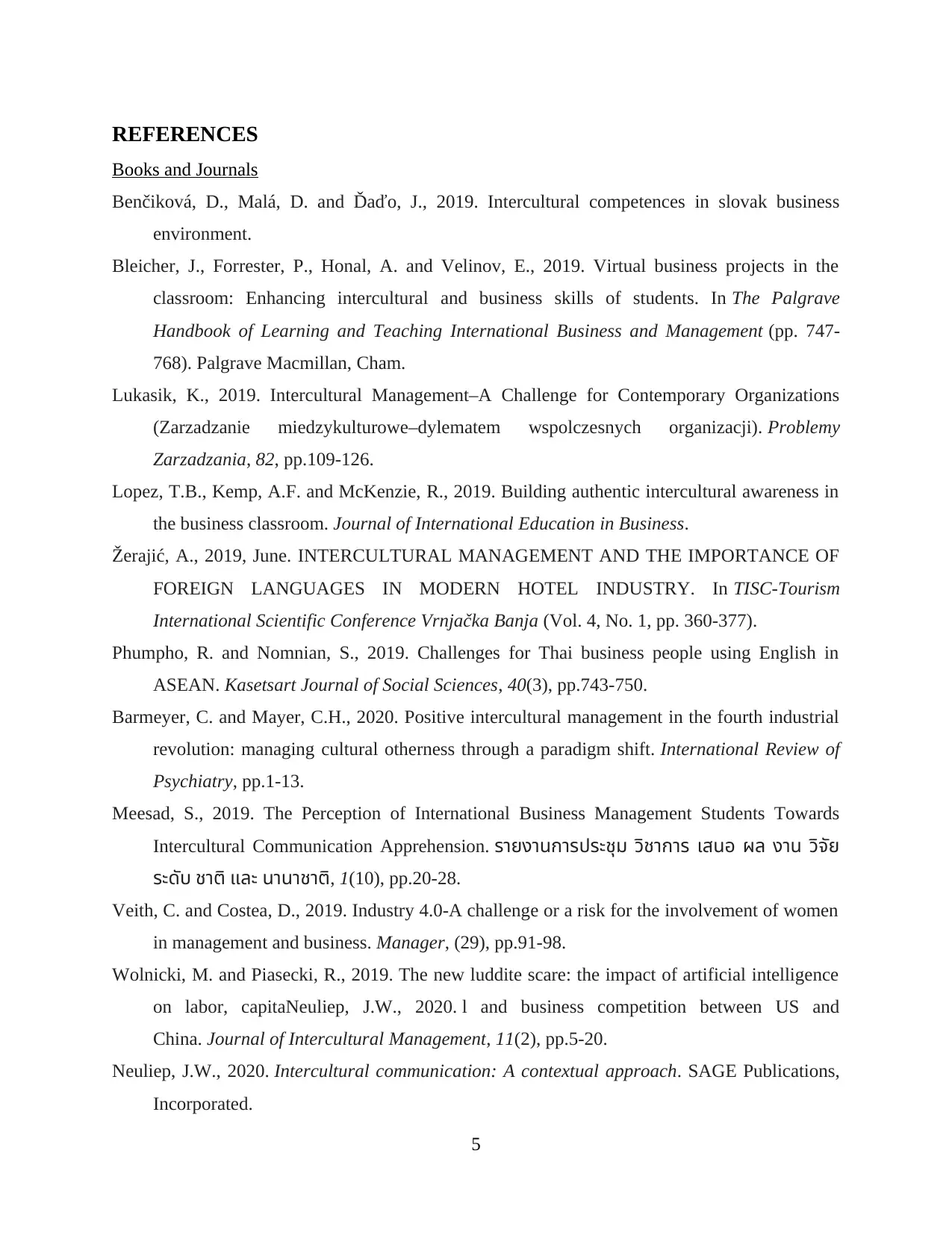
REFERENCES
Books and Journals
Benčiková, D., Malá, D. and Ďaďo, J., 2019. Intercultural competences in slovak business
environment.
Bleicher, J., Forrester, P., Honal, A. and Velinov, E., 2019. Virtual business projects in the
classroom: Enhancing intercultural and business skills of students. In The Palgrave
Handbook of Learning and Teaching International Business and Management (pp. 747-
768). Palgrave Macmillan, Cham.
Lukasik, K., 2019. Intercultural Management–A Challenge for Contemporary Organizations
(Zarzadzanie miedzykulturowe–dylematem wspolczesnych organizacji). Problemy
Zarzadzania, 82, pp.109-126.
Lopez, T.B., Kemp, A.F. and McKenzie, R., 2019. Building authentic intercultural awareness in
the business classroom. Journal of International Education in Business.
Žerajić, A., 2019, June. INTERCULTURAL MANAGEMENT AND THE IMPORTANCE OF
FOREIGN LANGUAGES IN MODERN HOTEL INDUSTRY. In TISC-Tourism
International Scientific Conference Vrnjačka Banja (Vol. 4, No. 1, pp. 360-377).
Phumpho, R. and Nomnian, S., 2019. Challenges for Thai business people using English in
ASEAN. Kasetsart Journal of Social Sciences, 40(3), pp.743-750.
Barmeyer, C. and Mayer, C.H., 2020. Positive intercultural management in the fourth industrial
revolution: managing cultural otherness through a paradigm shift. International Review of
Psychiatry, pp.1-13.
Meesad, S., 2019. The Perception of International Business Management Students Towards
Intercultural Communication Apprehension. รายงานการประชุม วิชาการ เสนอ ผล งาน วิจัย
ระดับ ชาติ และ นานาชาติ, 1(10), pp.20-28.
Veith, C. and Costea, D., 2019. Industry 4.0-A challenge or a risk for the involvement of women
in management and business. Manager, (29), pp.91-98.
Wolnicki, M. and Piasecki, R., 2019. The new luddite scare: the impact of artificial intelligence
on labor, capitaNeuliep, J.W., 2020. l and business competition between US and
China. Journal of Intercultural Management, 11(2), pp.5-20.
Neuliep, J.W., 2020. Intercultural communication: A contextual approach. SAGE Publications,
Incorporated.
5
Books and Journals
Benčiková, D., Malá, D. and Ďaďo, J., 2019. Intercultural competences in slovak business
environment.
Bleicher, J., Forrester, P., Honal, A. and Velinov, E., 2019. Virtual business projects in the
classroom: Enhancing intercultural and business skills of students. In The Palgrave
Handbook of Learning and Teaching International Business and Management (pp. 747-
768). Palgrave Macmillan, Cham.
Lukasik, K., 2019. Intercultural Management–A Challenge for Contemporary Organizations
(Zarzadzanie miedzykulturowe–dylematem wspolczesnych organizacji). Problemy
Zarzadzania, 82, pp.109-126.
Lopez, T.B., Kemp, A.F. and McKenzie, R., 2019. Building authentic intercultural awareness in
the business classroom. Journal of International Education in Business.
Žerajić, A., 2019, June. INTERCULTURAL MANAGEMENT AND THE IMPORTANCE OF
FOREIGN LANGUAGES IN MODERN HOTEL INDUSTRY. In TISC-Tourism
International Scientific Conference Vrnjačka Banja (Vol. 4, No. 1, pp. 360-377).
Phumpho, R. and Nomnian, S., 2019. Challenges for Thai business people using English in
ASEAN. Kasetsart Journal of Social Sciences, 40(3), pp.743-750.
Barmeyer, C. and Mayer, C.H., 2020. Positive intercultural management in the fourth industrial
revolution: managing cultural otherness through a paradigm shift. International Review of
Psychiatry, pp.1-13.
Meesad, S., 2019. The Perception of International Business Management Students Towards
Intercultural Communication Apprehension. รายงานการประชุม วิชาการ เสนอ ผล งาน วิจัย
ระดับ ชาติ และ นานาชาติ, 1(10), pp.20-28.
Veith, C. and Costea, D., 2019. Industry 4.0-A challenge or a risk for the involvement of women
in management and business. Manager, (29), pp.91-98.
Wolnicki, M. and Piasecki, R., 2019. The new luddite scare: the impact of artificial intelligence
on labor, capitaNeuliep, J.W., 2020. l and business competition between US and
China. Journal of Intercultural Management, 11(2), pp.5-20.
Neuliep, J.W., 2020. Intercultural communication: A contextual approach. SAGE Publications,
Incorporated.
5
Paraphrase This Document
Need a fresh take? Get an instant paraphrase of this document with our AI Paraphraser
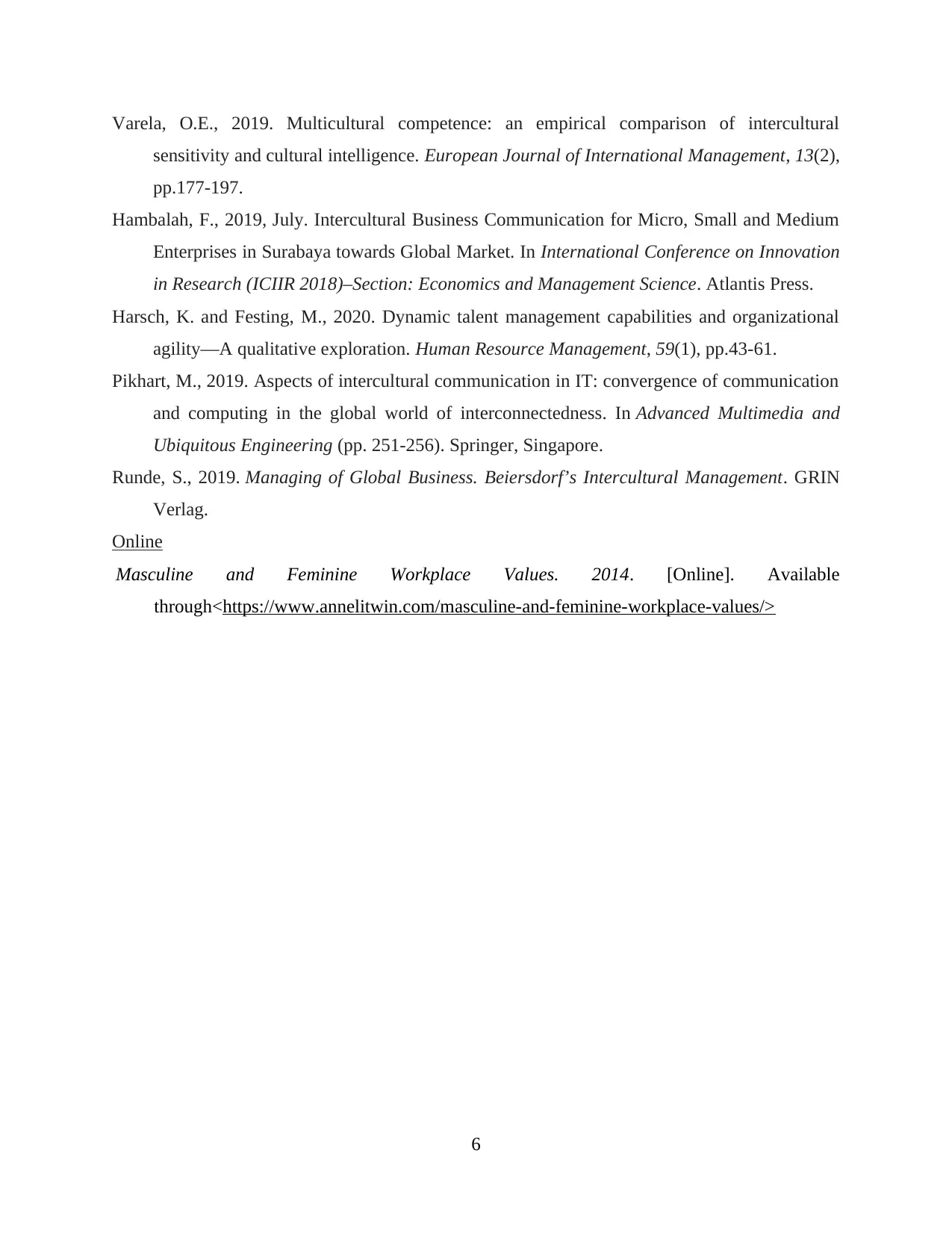
Varela, O.E., 2019. Multicultural competence: an empirical comparison of intercultural
sensitivity and cultural intelligence. European Journal of International Management, 13(2),
pp.177-197.
Hambalah, F., 2019, July. Intercultural Business Communication for Micro, Small and Medium
Enterprises in Surabaya towards Global Market. In International Conference on Innovation
in Research (ICIIR 2018)–Section: Economics and Management Science. Atlantis Press.
Harsch, K. and Festing, M., 2020. Dynamic talent management capabilities and organizational
agility—A qualitative exploration. Human Resource Management, 59(1), pp.43-61.
Pikhart, M., 2019. Aspects of intercultural communication in IT: convergence of communication
and computing in the global world of interconnectedness. In Advanced Multimedia and
Ubiquitous Engineering (pp. 251-256). Springer, Singapore.
Runde, S., 2019. Managing of Global Business. Beiersdorf’s Intercultural Management. GRIN
Verlag.
Online
Masculine and Feminine Workplace Values. 2014. [Online]. Available
through<https://www.annelitwin.com/masculine-and-feminine-workplace-values/>
6
sensitivity and cultural intelligence. European Journal of International Management, 13(2),
pp.177-197.
Hambalah, F., 2019, July. Intercultural Business Communication for Micro, Small and Medium
Enterprises in Surabaya towards Global Market. In International Conference on Innovation
in Research (ICIIR 2018)–Section: Economics and Management Science. Atlantis Press.
Harsch, K. and Festing, M., 2020. Dynamic talent management capabilities and organizational
agility—A qualitative exploration. Human Resource Management, 59(1), pp.43-61.
Pikhart, M., 2019. Aspects of intercultural communication in IT: convergence of communication
and computing in the global world of interconnectedness. In Advanced Multimedia and
Ubiquitous Engineering (pp. 251-256). Springer, Singapore.
Runde, S., 2019. Managing of Global Business. Beiersdorf’s Intercultural Management. GRIN
Verlag.
Online
Masculine and Feminine Workplace Values. 2014. [Online]. Available
through<https://www.annelitwin.com/masculine-and-feminine-workplace-values/>
6
1 out of 8
Related Documents
Your All-in-One AI-Powered Toolkit for Academic Success.
+13062052269
info@desklib.com
Available 24*7 on WhatsApp / Email
![[object Object]](/_next/static/media/star-bottom.7253800d.svg)
Unlock your academic potential
Copyright © 2020–2025 A2Z Services. All Rights Reserved. Developed and managed by ZUCOL.





